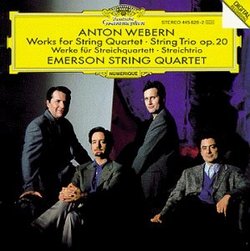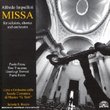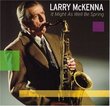| All Artists: Composer: Anton Webern, Performer: Emerson String Quartet Title: Webern: Works for String Quartet Members Wishing: 0 Total Copies: 0 Label: Deutsche Grammophon Release Date: 5/16/1995 Genre: Classical Style: Chamber Music Number of Discs: 1 SwapaCD Credits: 1 UPCs: 028944582826, 028944582826 |
Search - Composer: Anton Webern, Performer: Emerson String Quartet :: Webern: Works for String Quartet
 | Composer: Anton Webern, Performer: Emerson String Quartet Webern: Works for String Quartet Genre: Classical Opening with the longest single movement Anton Webern ever composed, this collection of his nine works for string quartet and trio covers his entire career. For starters, it bears reminding that the first, longest movement... more » |
Larger Image |
CD DetailsSynopsis
Amazon.com essential recording Opening with the longest single movement Anton Webern ever composed, this collection of his nine works for string quartet and trio covers his entire career. For starters, it bears reminding that the first, longest movement he wrote encompasses a mere nine minutes--glorious minutes, but only nine of them. They make up the 1905 string quartet, taken abundantly through its most sonorous dialogues by the Emerson String Quartet, who provide a lavish setting in Lawrence Dutton's viola for the crucial middle ground between David Finckel's robust cello and the sometimes jarred, sometimes whizzing violins of Eugene Drucker and Philip Setzer. Beyond the first string quartet, there are loads of vantages here from which to examine postserial music. For while Webern owed much to Schoenberg's revolution, he owed even more to an inherently economic sense of wholeness. These are miniatures, really, each cutting rapidly to the quick of the matter and finding sometimes abrupt completion. It's perfect music for an era when the tension between experimentation and economy of phrasing urges on creative motion. And here it's perfectly played: tense, sad, sweet, and urgent. --Andrew Bartlett Similar CDs
|
CD ReviewsEconomical emotional expression. Lord Chimp | Monkey World | 03/17/2006 (5 out of 5 stars) "Few things excite me like modernist chamber music, but Webern's works for string quartet have never really grabbed me. How disappointing! Or so I thought. Today I spent several hours listening through these pieces chronologically. Now it all makes sense: The longer pieces, all the earliest Webern wrote (the slow movement, the string quartet, and the rondo), are pleasant and unambitious. They all carry with them the influence of Webern's teacher, Arnold Schoenberg. These early pieces lack much in the way of identity and compositional rigor, as they seem to be more in the business of evoking _Verlarkte nacht_ and Schoenberg's first quartet than anything Webern-esque! After these early works, things get interesting -- and the only real `problem' is that Webern's compositions are so short that if your attention wanders for even a second you'll have missed a pivotal moment in the piece! Therein lies the challenge of "getting" the music. Webern's music is carried out with introverted efficiency so, as a listener, you must be very committed with your attention. The first piece to explore the alien world of atonality is _five movements for string quartet_, which lasts only eight or nine minutes. Its colorful gestures, like percussive effect by striking with the wood of the bow and progressive intervals, invite one into the exciting soundworld of artists setting out for the world of atonality, which is limited only by one's imagination. Webern's imagination blooms with great-yet-compact results, as he writes pieces even shorter than the _five movements_. Yet here, in a brief phase before he adopted Schoenberg's serialist method, he preserves affecting power of expression in pieces whose movements are virtually never longer than a minute. The _six bagatelles_ and _three pieces_, expressing loss and sadness, are painful to listen to. They are, it seems, "pieces" in a more denotative sense of the term -- fragments of painful emotion, rendered with articulate and unconventional language and technique. (the song-piece, the second part of the _three pieces_, is performed by mezzo-soprano Mary Ann-McCormick with exquisite pain). Three pieces for string trio and quartet emerge with the advent of serialism. These are remarkable pieces -- again, short but precious. Be it the angular, swirling motions a surprising melodicism of op.20, or the perfect, careful conception of op.28, with its deep lyrical beauty scattered across the different instruments with prudent economy and emotional sensitivity, Webern's late serialist chamber works are some of the finest to be offered. Webern's string music is epic in its emotional dimension, not its size and scope. Within these short pieces are systems of necessity, pure and without artificial extension. I can't believe it took me so long to appreciate them. " This is not a reference recording R. Hutchinson | 01/29/2004 (3 out of 5 stars) "There have never been so many recordings of Webern's music in the market as now, and the string quartets are particularly well-represented. However, the present recording of the quartets and trios is very far from being the best one, especially concerning the early pieces (without opus-number) that sound rather unrehearsed and unexpressive. It is lamentable that just this recording was included in DG's "Complete Webern" box. Instead of this CD I recommend the recording with the Arditti Quartet (Disques Montaigne; this CD was released at least 3 times since 1991). The Schoenberg Quartet and the Leipzig Quartet have also released very good CDs but the choice of pieces is not quite the same. The recording with the Quarteto Italiano is unfortunately out of the catalogue since many years." A personal point of view Bahij Bawarshi | Beirut, Lebanon | 04/15/2009 (4 out of 5 stars) "I hesitated before attempting a review of this CD. I use the word "review" as a concession to common usage on the Amazon pages. Real reviews of the music contained here are best left to professional critics. What I write are the thoughts and sentiments of a longtime listener to classical music of all periods. I often listen to the string quartets of Janacek, Bartok, Shostakovich, and Britten, and enjoy them immensely. I mention these composers in particular because, like Webern, their sound world is a product of the twentieth century, though their methods are not the same.
This recording of nine works for string quartet and string trio embraces Anton Webern's early, middle and late compositions in the genre. Three works represent each period. Webern composed the early pieces (1905/06) when he was still a student under Schoenberg. The earliest, Slow Movement for String Quartet, is a beautifully lyrical composition. String Quartet (1905) is a one-movement work (lasting for 15 minutes, the longest of the CD), and comprises three sections corresponding to the three panels of Italian painter Giovanni Segantini's triptych, "Werden - Sein - Vergehen" (Becoming - Being - Passing away), that had inspired Webern. As played by Emerson String Quartet, it begins enigmatically, rises to intense emotional expression, before subsiding to a peaceful, resigned ending. This is the only piece on the CD that I can compare to another version. Two years ago I bought a DG recording of Hagen Quartett playing the Debussy and Ravel string quartets, which also had the Webern 1905. I liked the Webern quartet almost immediately. Hagen's performance is similar to Emerson's but is more evocative than emotional -- as played, the quartet fits well with the French compositions, I think. The Rondo (1906), like the other two works of the early period, presents no particular problem. I don't believe anyone used to twentieth century quartet sound will shrink away from these three. The middle-period works (1909 - 1913) are a different matter, not because of their rigorous atonality, but mainly because their extreme brevity makes it difficult for listeners to connect with the music. I'll be honest and say I don't *enjoy* the music but am fascinated by it, drawing me as it does into a strange world of expression. It takes less than 11 minutes to play Five Movements op. 5. The middle movement is marked 0'42, but actual playing time is 37 seconds, the rest being slack time between movements. More extreme is Six Bagatelles. The longest movement is marked 1'42, and the other five range from 22 to 50 seconds, including slack. In his excellent Guide to Chamber Music, Melvin Berger quotes Schoenberg's statement on Six Bagatelles that I find exaggerated, where he says, "One has to realize what restraint it requires to express oneself with such brevity. You can stretch every glance into a poem, every sigh into a novel." I admit, I can't. More reasonable is his other statement, "These pieces can only be understood by those who believe that music can say things that can only be expressed by music." And most down to earth is Berger's own conclusion: "Short of a note by note analysis, perhaps the best advice is to approach 'Six Bagatelles' as a unique adventure in sound that has few parallels in the chamber music repertoire." In 1913 Webern composed Three Pieces for String Quartet. Its first and last movements in modified form became the first and last movements of Six Bagatelles (originally comprised of four movements). In the middle movement of Three Pieces, the haunting voice of mezzo-soprano Mary Ann McCormick goes to the core. Webern must have been expressing deeply felt emotion when he composed the song. We know that he had once written to his friend and fellow student Alban Berg that most of his compositions related to the death of his mother. The emotion doesn't always appear on the surface; we have to assume that Webern tried to communicate it in his own introspective and original way, and that it remains up to the listener to come to grips with it. The late-period pieces are Movement for String Trio published posthumously, String Trio op. 20, and String Quartet op. 28. These are still brief works, but at least the individual movements are measured in minutes, not seconds! In this phase, Webern started employing the advanced technique of serialism, in which elements of music such as pitch, tone color, and rhythm were organized in sets, to rich effect. Previously, he had applied Schoenberg's 12-tone method of composition strictly, and could write in connection with Six Bagatelles, "Here I had the feeling that when the twelve notes had all been played, the piece was over." Now he could compose using twelve tones -- and had the flexibility for the piece to go on, and could even write canons and fugues. The culminating work, String Quartet op. 28, was Webern's pride -- Berger cites him as writing, "I must confess that hardly ever before I felt so good about a work of mine (after its completion) as I do this time." The more I listen to the late works, the more I appreciate them, and each time I listen becomes a challenge to discover more in them." |



![Mozart: The Wind Concertos, Serenades [Box Set]](https://nationalbookswap.com/cd//m/16/0616/6140616.jpg)
